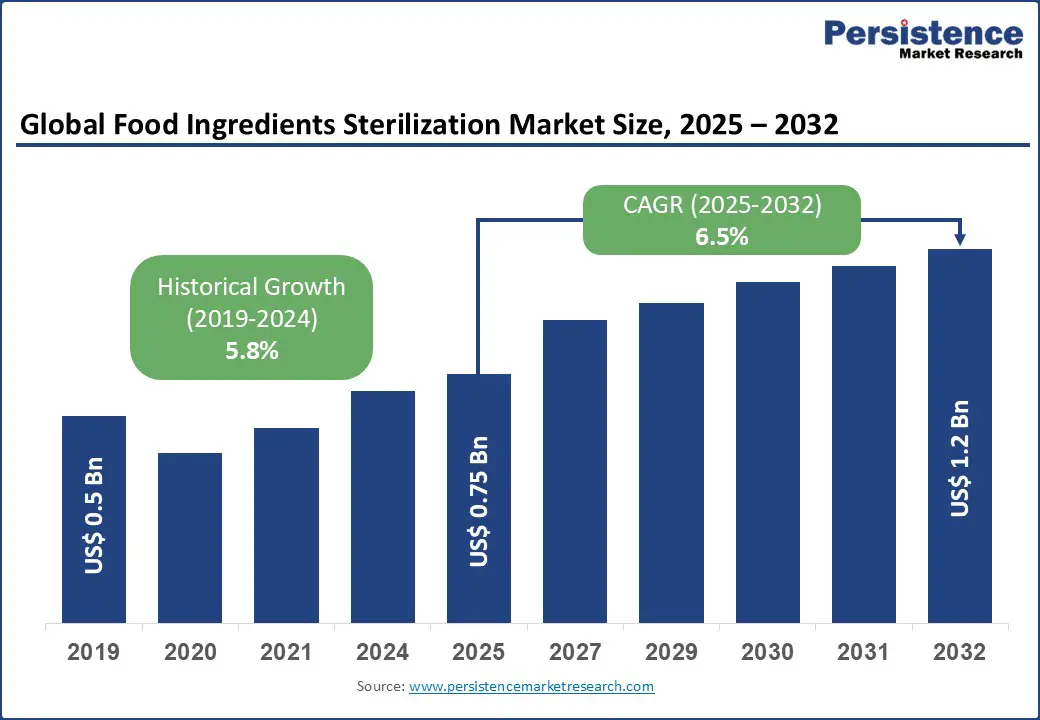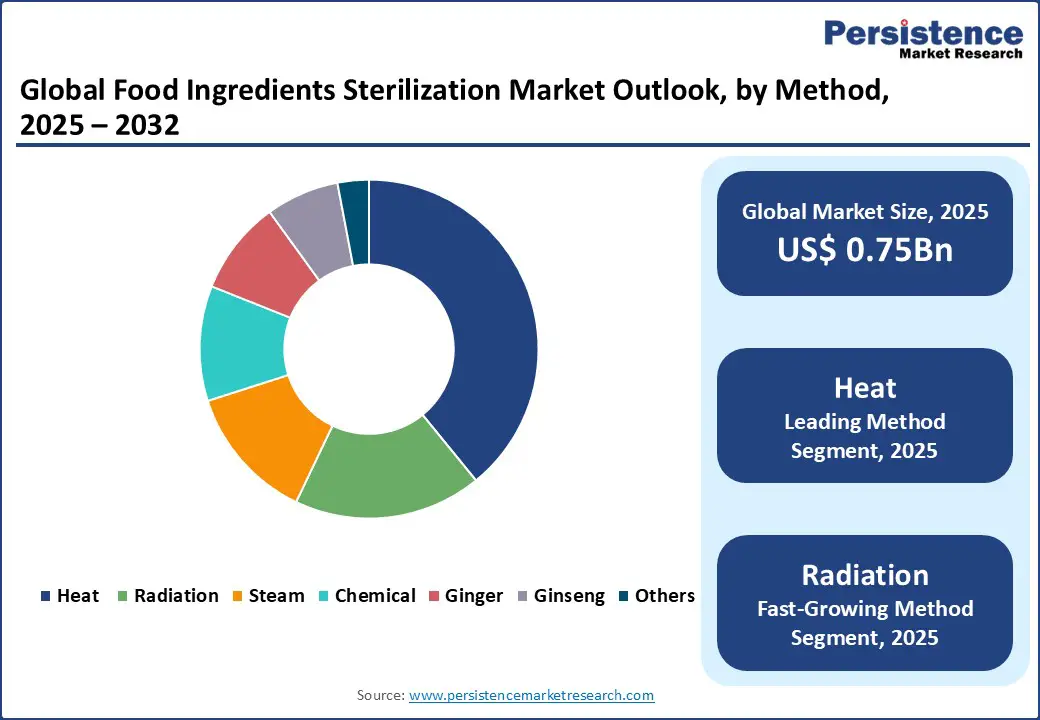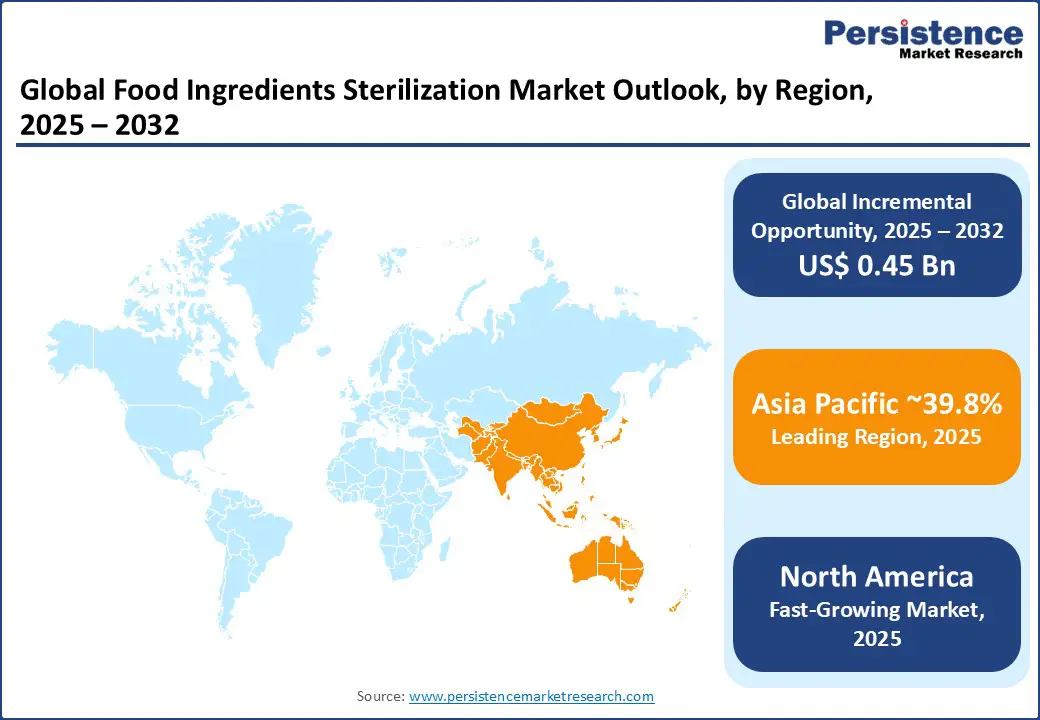ID: PMRREP12724| 190 Pages | 23 Sep 2025 | Format: PDF, Excel, PPT* | Food and Beverages

The global food ingredients sterilization market size is likely to value at US$ 0.75 Bn in 2025 and reach US$ 1.2 Bn by 2032, growing at a CAGR of 6.5% during the forecast period from 2025 to 2032.
The food ingredients sterilization market is experiencing robust growth, driven by increasing demand for safe, high-quality food products across the food and beverage industry. Food ingredient sterilization ensures the elimination of harmful microorganisms, extending shelf life while preserving nutritional value and sensory qualities.
Advancements in sterilization technologies, such as cold plasma and non-thermal methods, support market expansion by meeting stringent food safety regulations. Rising consumer demand for minimally processed and packaged foods, coupled with global food safety standards, further fuels market growth.
Key Industry Highlights

| Key Insights | Details |
|---|---|
| Food Ingredient Sterilization Market Size (2025E) | US$ 0.75 Bn |
| Market Value Forecast (2032F) | US$ 1.2 Bn |
| Projected Growth (CAGR 2025 to 2032) | 6.5% |
| Historical Market Growth (CAGR 2019 to 2024) | 5.8% |
The global food ingredients sterilization market is witnessing significant growth due to the rising demand for food safety and extended shelf life in the food and beverage industry.
Sterilization eliminates pathogens and spoilage organisms, ensuring compliance with stringent global regulations, such as the U.S. FDA’s Food Safety Modernization Act and the EU’s General Food Law. According to the World Health Organization, each year, an estimated 600 million people fall ill and 420,000 people die from unsafe food, driving the need for effective sterilization solutions.
In the Asia Pacific, China’s food processing industry relies heavily on sterilization to meet export standards. Companies such as Sterigenics International LLC reported an increase in sterilization equipment for packaged foods in 2024. The growing popularity of convenience foods, particularly in urban areas, further amplifies demand, positioning food safety as a key driver for market growth through 2032.
The food ingredients sterilization market encounters significant hurdles primarily due to the high capital investment and operational complexity of advanced technologies. Non-thermal methods such as cold plasma and irradiation, while effective, demand substantial upfront costs, making them less accessible to small and medium-sized enterprises (SMEs).
These systems also require specialized technical knowledge for operation and maintenance, increasing ongoing operational expenses.
Furthermore, traditional methods such as heat sterilization remain preferred due to their lower cost and simplicity, intensifying market competition. Regulatory inconsistencies across countries add another layer of complexity, making global compliance difficult for manufacturers.
Consumer skepticism toward non-thermal techniques, especially irradiation, further impedes adoption, particularly in developing economies where awareness and infrastructure are limited. These combined factors collectively restrain market growth, despite increasing demand for safer and more efficient food sterilization solutions.
The increasing focus on minimally processed and premium food products presents significant opportunities. Non-thermal sterilization methods, such as high-pressure processing and cold plasma, preserve the nutritional and sensory qualities of premium foods, aligning with consumer preferences for clean-label products.
The global organic food market, drives demand for these advanced technologies. Companies such as Napasol AG are innovating with radiation-based solutions for organic spices, catering to the premium food segment.
Additionally, government policies such as the EU’s Farm to Fork Strategy emphasize sustainable and eco-friendly food processing, incentivizing investments in greener sterilization solutions. These evolving consumer trends and regulatory support encourage manufacturers to develop cutting-edge, sustainable sterilization technologies, driving robust market growth and broadening adoption through 2032.

Asia Pacific dominates in 2025, commanding a substantial 39.8% share in 2025. This leadership is fueled by the rapid expansion of food processing industries, particularly in China and India, coupled with increasingly stringent food safety regulations.
China, recognized as the world’s largest food processing hub, plays a pivotal role with its massive production capacity and robust regulatory framework that emphasizes sterilization standards to ensure consumer safety. India’s growing food processing sector, bolstered by government initiatives such as Make in India, particularly drives demand in key segments such as spices and dairy products.
Regional companies such as Safe Spice and Namah Steam Sterilization are strategically expanding operations to serve both domestic and export markets, addressing the needs of global buyers with high safety standards.
Additionally, urbanization and rising packaged food consumption across the Asia Pacific, alongside proactive government food safety programs, create a conducive environment for continued market growth, securing the region’s dominance through 2032.
North America is the fastest-growing region in the food ingredients sterilization market, propelled by its advanced food processing infrastructure and increasing demand for packaged foods across the U.S. and Canada.
The U.S. agriculture, food, and related industries contributed approximately $1.530 trillion to the national GDP in 2023, representing about 5.6% of the total, underscoring the sector’s economic significance. Sterilization plays a critical role in ensuring the safety and quality of key products such as meat, dairy, and cereals, which are staples in North American diets.
Canada’s robust food export industry further amplifies demand for high-quality sterilization technologies to meet international standards. Industry leaders such as Sterigenics International LLC and Cosmed Group lead the food ingredients sterilization market with innovative solutions, ensuring compliance with stringent FDA and Canadian regulations.
Additionally, growing consumer preference for safe, minimally processed foods and efficient distribution networks enhances market growth, positioning North America for sustained expansion through 2032.
Europe ranks as the second fastest-growing region in the food ingredients sterilization market, driven by stringent food safety regulations, growing demand in premium food segments, and significant investments in sustainable food processing, especially in Germany and France.
According to FoodDrinkEurope’s *Data & Trends of the European Food and Drink Industry 2024* report, the sector generated a turnover of €1.2 trillion in 2024, underlining its economic importance and supporting robust demand for sterilization technologies in key segments such as dairy and spices.
Germany’s premium food market benefits from innovative companies such as Napasol AG, which offers advanced radiation-based sterilization solutions tailored for high-quality products.
Moreover, the EU’s Farm to Fork Strategy emphasizes sustainable, eco-friendly food processing, encouraging wider adoption of non-thermal sterilization methods in organic and clean-label food production. This combined focus on sustainability, regulatory compliance, and consumer demand for safe, high-quality foods fosters continuous innovation and positions Europe for sustained market growth through the coming decade.

The global food ingredients sterilization market is highly competitive and fragmented, with numerous domestic and international players. Leading companies, such as Napasol AG, Sterigenics International LLC, and Balchem Corporation, dominate through extensive product portfolios and global distribution networks.
Regional players, such as Safe Spice focus on localized offerings in the Asia Pacific. Companies are investing in advanced sterilization technologies, such as non-thermal methods, to enhance market share, driven by demand for high-quality, safe food products in the food and beverage and agriculture sectors.
The Food Ingredients Sterilization market is projected to reach US$0.75 Bn in 2025.
Increasing demand for food safety and extended shelf life, and expanding applications in premium food segments are the key market drivers.
The Food Ingredients Sterilization market is poised to witness a CAGR of 6.5% from 2025 to 2032.
The growing adoption of non-thermal sterilization in premium food segments is the key market opportunity.
Napasol AG, Sterigenics International LLC, Balchem Corporation, and Cosmed Group are key market players.
| Report Attribute | Details |
|---|---|
| Historical Data/Actuals | 2019 - 2024 |
| Forecast Period | 2025 - 2032 |
| Market Analysis | Value: US$ Bn/Mn, Volume: As Applicable |
| Geographical Coverage |
|
| Segmental Coverage |
|
| Competitive Analysis |
|
| Report Highlights |
|
By Method
By Process
By Application
By Region
Delivery Timelines
For more information on this report and its delivery timelines please get in touch with our sales team.
About Author